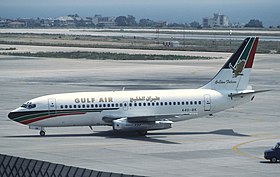Gulf Air Flight 771
| Gulf Air Flight 771 | |
|---|---|
|
The A4O-BK accident machine |
|
| Accident summary | |
| Accident type | Bomb attack |
| place |
Mina Jabal Ali , United Arab Emirates |
| date | September 23, 1983 |
| Fatalities | 112 |
| Survivors | 0 |
| Aircraft | |
| Aircraft type |
|
| operator |
|
| Mark |
|
| Departure airport |
Karachi Airport , Pakistan |
| Destination airport |
Abu Dhabi Airport , United Arab Emirates |
| Passengers | 107 |
| crew | 5 |
| Lists of aviation accidents | |
On September 23, 1983, a heavy bomb attack occurred on Gulf Air flight 771 (flight number: GF771 ) in which a Gulf Air Boeing 737-2P6 crashed near Mina Jabal Ali in the United Arab Emirates as a result of a bomb explosion on board. All 112 people on board the machine died in the incident.
It is one of the two most serious aviation accidents in the United Arab Emirates, the other being Sterling Airways Flight 296 .
machine
The aircraft involved in the accident was a Boeing 737-2P6, which was 4 years and 5 months old at the time of the accident. The machine was assembled at the Boeing plant in Renton , Washington , and completed its maiden flight on April 4, 1978, before being delivered to Gulf Air two weeks later. The aircraft had the factory number 21734, it was the 566th Boeing 737 from ongoing production. The machine was certified with the Omani aircraft registration A4O-BK . The twin- engined narrow -body aircraft was equipped with two Pratt & Whitney JT8D-15 engines.
Passengers and crew
There were 107 passengers on board, most of whom were Pakistani citizens, who worked in Abu Dhabi and Dubai and were on their way back after a stay in their homeland. There was also a five-person crew on board. The cockpit crew consisted of the Omani captain Saud Al Kindi, the first officer Khazal Al Qadi came from Bahrain . There were also three flight attendants on board, including the British stewardess Lyn Farthing.
Course of the flight and course of the accident
The plane took off from Karachi Airport in Pakistan . The flight proceeded without incident until it entered the airspace of the United Arab Emirates. When the machine flew into the airspace of the Emirate of Dubai, a bomb exploded in the cargo compartment. This led to a fire on board. The pilots declared an air emergency and tried to keep the machine under control, but they did not succeed. The machine hit Jebel Ali in the desert.
Accident investigation
The United Arab Emirates Aviation Authority was assisted in the aircraft accident investigation by the National Transportation Safety Board .
When evaluating the cockpit voice recorder , the atmosphere in the cockpit made a normal impression until shortly before the impact. The pilots had relaxed conversations. One pilot asked the other if he would be on duty the next day, which he said no. The conversation was suddenly interrupted, then the recordings could be heard as the pilots tried in panic to keep the machine under control. While the machine was nipping towards the ground, the captain prayed.
A bomb explosion was suspected to be the cause of the crash based on several factors:
- A passenger had checked in a suitcase in Karachi, but had not boarded the plane
- The injuries to the passengers who had sat above the cargo compartment matched those that would have been expected in a bomb explosion.
- The sudden interruption on an otherwise inconspicuous flight
- The flight data logger indicated a bomb explosion.
Asphyxiation was given as the cause of death in the passengers' death certificates.
Originator
It has been suggested that the bomb was placed by the Abu Nidal organization to get the government of Saudi Arabia to pay protection money to the organization.
swell
- Abu Nidal behind 1983 Gulf Air bombing: Aide , indiainfo.com dated August 22, 2002.
- Accident report in the Aviation Safety Network .
- Investigation into Gulf plane crash , UPI News , September 23, 1983.
- 112 Aboard Airliners Are Killed in Crash in Persian Gulf Sheikdom , New York Times, September 24, 1983.
